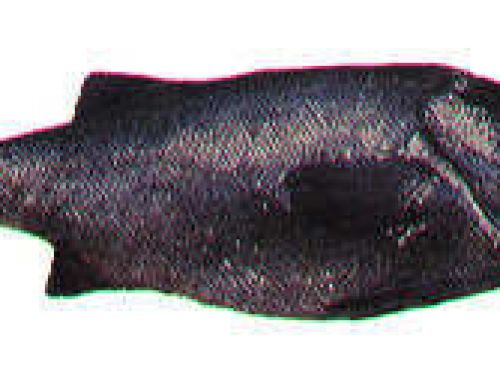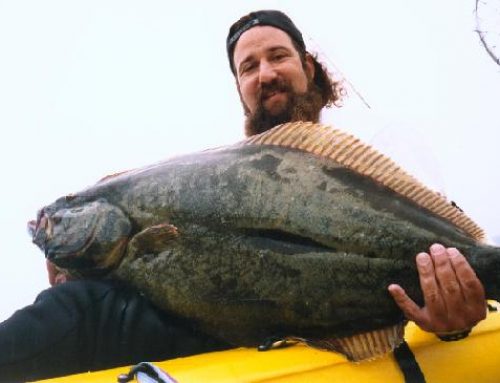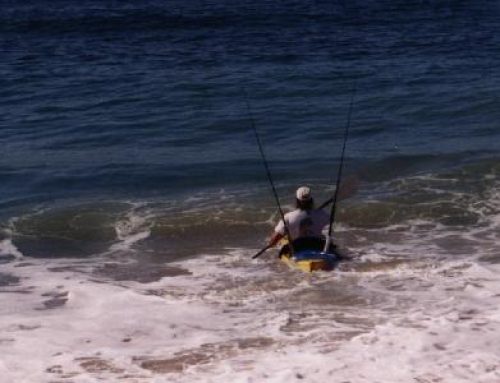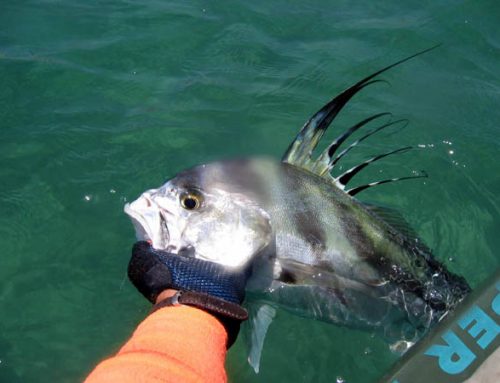Most people believe that fishing from kayaks is a new sport, spurred by the popularity of the inexpensive plastic vessels. Truth is there have been anglers fishing everything from longboards to dive kayaks for many decades. When it comes to kayak fishing, we all paddle in the wake of the old kayak hunters. Where they used kayaks for transportation and harvesting game to survive, we have “beat the system” so to say, and enjoy an ongoing orgy of fishing from our modified kayaks. The pre-modern kayak hunters sought seals, salmon, and whales for food. Nearly everyone had at least one friend or family member who never returned from sea. Just the same, the kayaks were legendary for their seaworthiness. As the ancient methods crossed paths with 20th century navigation, kayak hunters were known to return home after disastrous storms that had taken modern boats and the lives entrusted to them.
Considering the period, what a rush it must have been to stick a whale, then hold on to 50 feet of homemade rope as you are dragged out to sea. Beyond sight of land with no compass and your buddies paddling hard for hours to keep you in view, no wonder some did not return. It makes sense to theorize that the most extreme examples of kayak fishing and hunting were motivated by the threat of starvation. Today’s kayak anglers are motivated by two things. The ability to easily add 50 days a year to their fishing schedule is the main reason most people fish from kayaks. The potential for some very extreme quality fishing attracts the rest.
One such individual who started fishing from his kayak on the extreme side is Jeff “Rhino” Krieger. Inspired by a story in the Hawaiian Fishing News, Rhino fashioned a hand-line and float system and went looking for the jumping marlin off the inshore, the thresher shark. Krieger paddles a Scrambler XT kayak which he customized with the “Rhino Bar,” a rail with a sonar screen and trolling rod holder attachments, mounted forward of the footwell. The bar is also used for tying off the rigging (shark) when paddling in to shore, something I will touch on later. Always looking to learn something new, this writer jumped at the chance to get a lesson on landing threshers in a kayak. Arriving with first light and my fishing partner, we set out to make a few baits and work the rocks around Point Dume for while seabass or yellowtail. On the water we were passed by another kayak angler hauling a five gallon bucket for his bait. Fifteen minutes later, he had a big bend on in what resulted in a lost fish. Except for a few calico bass, we weren’t doing any better. Suddenly I looked up, and the bucket hauler is again hooked up when a thresher breaks water ahead of him. Knowing what was going on, we paddled over to offer our assistance. The angler’s eyes were as big as saucers when he declined our help and reached for a knife to cut the line. I hate to see a fish (or shark) trailing a hook let alone 200 feet of mono, and when this “angler” was advised that he wouldn’t catch the yellowtail he sought soaking a salami mackerel within a feeding frenzy of thresher sharks, he went away.
Several times I have fished deep water areas and consistently been bit off within a particular water column, only to read about the boats I left behind landing 300 pound threshers. When I started fishing from a kayak the shark thing was a concern, kind of. Then I got lucky enough to meet a commercial diver who worked the Channel Islands harvesting sea urchins. When asked about the implications of big sharks in the water, he discounted my concerns and said the sharks don’t really access the different levels the way our fears would lead us to believe. When sharks are circling the diver
Using a 5/0 hook on a 200 pound leader with a mainline of 400 pound tuna chord, Rhino baits a mackerel and lays his float out.
working at the bottom, they don’t follow him up as he rises to the boat. When asked about when the divers leave the water due to sharks, his reply was simply “when there are too many to keep your eye on. ” When you fish our coast with a kayak you see how many people make their living in the water every day, without incident.
Southern California is believed to be a nursery for many species of sharks. According to John Ugoretz, DF&G biologist involved with the state shark tagging program, “while the big common threshers are found mostly in the northern waters of Oregon and Washington, Southern California holds mostly “medium” size threshers and a lot of pups”. Very little is known about the thresher shark in regard to its presence on our coast. With this in mind, the National Marine Fisheries Service is currently implementing a program to conduct satellite tagging and tracking of the thresher sharks of Southern California. Knowing where the sharks travel will give us data crucial to the health of this fishery as well as provide the vital information for necessary management. The thresher is a perfect candidate for this program since it produces 2-6 live offspring and has proven its ability to rebound faster from overfishing than other shark species. During the course of the year certain tight inshore areas are polluted with calved and juvenile threshers (I assume) feeding on schools of bait. Unlike most sharks, the thresher gives birth to live pups. These “pups” are four to five feet long at birth and only four to five years old when they reach 10 feet. Since it is believed that the common thresher breeds at six to seven years old, respect must be given to the take of these ocean predators, especially when most of the sharks hooked are juveniles.
Fishing like a gentleman and arriving two hours after the last ‘yak has hit the water, Rhino trolls up a few mackerels on his way out and gets set to fish. Using a 5/0 hook on 200 pound leader with a mainline of 400 pound tuna chord, Rhino baits a mackerel and lays his float out. Twenty minutes doesn’t go by before the float makes a few bobs and starts moving under the surface. Barehanded (and barefooted) he takes the line taught and sets the hook. With that a six foot thresher broke water 40 feet from the kayaks. Taking lots of short runs, pulling the float, Rhino and the kayak all over the place, the shark took a few more leaps before it began to tire out. At that point, Rhino brings the shark alongside the kayak and while gently lifting its head from the water, he grabs the tail and hoists the lower half of it’s body over his lap, at the same time letting the head drop. Now the head and body are pointing down into the water. The group looks on in amazement.
Even a small tired thresher can be a handful given the slightest burst of energy. That is when teamwork and a good release tool is crucial. A thick broomstick with a small caribeener fastened to the end is inexpensive and easy to make. Popping the hook free is often enough to awaken a sleeping thresher. Once the hook is out, within a split second, send the shark into the water and mind that tail! If the hook is buried, there is no problem positioning the shark’s mouth away from you and cutting the line up close with nippers. Holding on to that tail really takes away the shark’s leverage and an easy release can be effected.
Rhino Krieger’s biggest landed thresher is a 90 pounder. It took over 1 1/2 hours to tire and was landed by bringing the tail across the lap and securing it under the Rhino Bar once the shark had become totally exhausted, then paddling to shore. With the shark restrained in this fashion, it will not have the opportunity to swim and will weaken further
by Jon Schwartz
East Cape of Baja, California Sur





